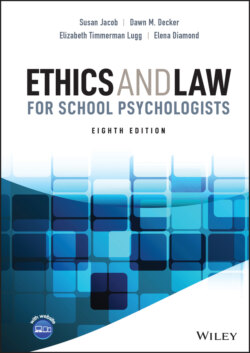Читать книгу Ethics and Law for School Psychologists - Susan Jacob - Страница 75
Case 2.1
ОглавлениеMahanoy Area School District v. B.L. (2021)
Mahanoy Area School District v. B.L. concerned a 9th grade student, Brandi Levy, who posted Snapchat images to her circle of friends expressing frustration after she failed to make the varsity cheerleading squad. The posts included Brandi with a middle finger raised and the caption “Fuck school… fuck cheer fuck everything” (2021, p. 2). Brandi did not identify the school, nor did she direct her crude language towards a school staff member. The post was shared with the cheerleading coach, and because the use of profanity violated team and school rules, Brandi was suspended from the junior varsity cheerleading team for one year. Despite her apologies, the school board refused to reverse the suspension, and Brandi’s parents subsequently filed a lawsuit arguing that the school’s punishment violated Brandi’s First Amendment right to free speech.
A district federal court, relying on Tinker (1969), found that the Snapshot posts had not caused a substantial disruption of school functioning, and ruled in Brandi’s favor. The school appealed. The Third Circuit court also held that Brandi’s speech did not interfere with “the work of the school or impinge on the rights of other students.” However, the Third Circuit Court also opined that public schools do not have the authority (“license”) to discipline off-campus student speech (2021, p. 3). The school district subsequently asked the Supreme Court to decide “whether [Tinker], which holds that public school officials may regulate speech that would materially and substantially disrupt the work and discipline of the school, applies to student speech that occurs off campus” (p. 4).
The Supreme Court opinion, written by Justice Breyer, relied on Tinker and weighed student First Amendment rights versus school interests as they apply to the specifics of the case. He reaffirmed that schoolchildren are entitled “to a significant measure of First Amendment protection,” but that courts must apply the First Amendment “in light of the special characteristics of the school environment” (2021, p. 5). He explained that: “we do not believe that the special characteristics that give schools additional license to regulate student speech always disappear when a school regulates speech that takes place off campus” (p. 5). He further opined that, with remote and other computer-based learning, the distinction between on-campus and off-campus activity is no longer clear cut, and he identified examples of off-campus speech that might call for school regulation, including bullying or threats targeted to students or teachers or cheating on papers or assignments.
The Court also identified three features that distinguish off-campus speech from on-campus speech in the context of regulation. First, schools do not stand in loco parentis when the student is off-campus and not at a school activity. Second, because allowing school regulation of off-campus speech would regulate student communication 24 hours a day, it could chill protected speech resulting in students being unable to speak at all. And third, the school itself has an interest in protecting a student’s unpopular expression, especially when the expression takes place off campus, because America’s public schools are the nurseries of democracy. Taken together, these three features of much off-campus speech mean that the leeway the First Amendment grants to schools in light of their special characteristics is diminished (pp. 6–8).
Like the lower courts, the Supreme Court found no evidence that Brandi’s crude off-campus Snapchat protest resulted in a “substantial disruption of school activity or a threatened harm to the rights of others that might justify the school’s action” (p. 10; here quoting Tinker) and ruled in Brandi’s favor.
The First Amendment protections of the speech of school-employed psychologists are addressed in Chapter 12 of the book. As will be seen, a tension exists between the school psychologist’s obligation to advocate for the bests interests of students and the limitations to their free speech as a public school employee.
